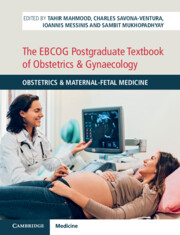Book contents
- The EBCOG Postgraduate Textbook of Obstetrics & Gynaecology
- The EBCOG Postgraduate Textbook of Obstetrics & Gynaecology
- Copyright page
- Dedication
- Contents
- Contributors
- Preface
- Section 1 Basic Sciences in Obstetrics
- Section 2 Early Pregnancy Problems
- Section 3 Fetal Medicine
- Section 4 Maternal Medicine
- Section 5 Intrapartum Care
- Section 6 Neonatal Problems
- Section 7 Placenta
- Section 8 Public Health Issues in Obstetrics
- Section 9 Co-Morbidities during Pregnancy
- Chapter 72 Management of Malignant and Premalignant Disease of the Cervix during Pregnancy
- Chapter 73 Breast Cancer and Pregnancy
- Chapter 74 Gynaecological Cancers and Pregnancy
- Chapter 75 Non-Gynaecological Cancers and Pregnancy
- Chapter 76 Simulation for Obstetric Emergencies
- Index
- Plate Section (PDF Only)
- References
Chapter 72 - Management of Malignant and Premalignant Disease of the Cervix during Pregnancy
from Section 9 - Co-Morbidities during Pregnancy
Published online by Cambridge University Press: 20 November 2021
- The EBCOG Postgraduate Textbook of Obstetrics & Gynaecology
- The EBCOG Postgraduate Textbook of Obstetrics & Gynaecology
- Copyright page
- Dedication
- Contents
- Contributors
- Preface
- Section 1 Basic Sciences in Obstetrics
- Section 2 Early Pregnancy Problems
- Section 3 Fetal Medicine
- Section 4 Maternal Medicine
- Section 5 Intrapartum Care
- Section 6 Neonatal Problems
- Section 7 Placenta
- Section 8 Public Health Issues in Obstetrics
- Section 9 Co-Morbidities during Pregnancy
- Chapter 72 Management of Malignant and Premalignant Disease of the Cervix during Pregnancy
- Chapter 73 Breast Cancer and Pregnancy
- Chapter 74 Gynaecological Cancers and Pregnancy
- Chapter 75 Non-Gynaecological Cancers and Pregnancy
- Chapter 76 Simulation for Obstetric Emergencies
- Index
- Plate Section (PDF Only)
- References
Summary
The rate of abnormal cytology smears during pregnancy is similar to that of non-pregnant women (around 5% in the USA). As expected, most of these abnormal smears are pre-cancerous cervical lesions, and cervical cancer during pregnancy is a rare event. However, it remains the most common cancer diagnosed during pregnancy, with an incidence rate of 12 per 100 000 pregnancies in the USA [1].
- Type
- Chapter
- Information
- The EBCOG Postgraduate Textbook of Obstetrics & GynaecologyObstetrics & Maternal-Fetal Medicine, pp. 587 - 594Publisher: Cambridge University PressPrint publication year: 2021

